Home » Jazz Articles » Live Review » Beishan International Jazz Festival, China, 19-20 October 2012
Beishan International Jazz Festival, China, 19-20 October 2012

Beishan Theater
Nanping Town, Zhuhai, China
10-20 October, 2012
Jazz festivals occupy some fairly far-flung, diverse, and oftentimes dramatic settings; from the Polar North to the volcanic mountains of East Java, from medieval European towns to the great urban metropolises of North America, from tropical Thai islands to luxury cruise ships, from Borneo to Central America and all places in between. But a jazz festival in a 200-year-old Chinese theatre and temple complex dating from the Qing dynasty-the last of the great imperial dynasties before the foundation of the Chinese Republic-is a first.
The Beishan International Jazz Festival in Zhuhai was actually celebrating its third edition, and judging by the packed house and vibrant, enthusiastic crowds on each of the two nights, it's clear that jazz in this part of the world is resonating greatly with a young, music-hungry audience.
The Beishan International Jazz Festival is the brainchild of artists and music-loving brothers Simone and Justine Xue. With the profits from their English school of many years standing, the Xue brothers purchsed the dilapidated theater and adjacent temple buildings and set about restoring them: "We bought the theater and temple six years ago," says Festival Curator Simone, "but we weren't sure exactly what to do with it. We knew we wanted to do something, and a few years ago, we thought, yeah, a jazz festival," he says with a mischievous grin.
The idea of a jazz festival in a city all but devoid of jazz might have raised a few eyebrows at the time, but in just three years the Beishan International jazz Festival has established itself as an essential date in Zhuhai's cultural calendar, one of the best jazz festivals-and their numbers are growing-in southern China.
Situated on the southwestern estuary of the Pearl River, the city of Zhuhai is just a 50-minute ferry ride from Hong Kong to the east. To the south, Zhuhai borders Macau, and with Jiangmen to the west and Zhongshan to the south, this modern city of 1.5 million people is a tourism and transportation hub. Having won national and international awards for its sound environmental policies, the city boasts 300 kilometers of bicycle lanes. Green, spacious, famous for its oysters and flanked by mountains, Zhuhai has a lot going for it, and the Xue brothers were confident that a jazz festival would work.
From an artistic point of view the BIJF set the bar high from the get-go, with an ambitious program that refused to underestimate a young audience largely unfamiliar with jazz. In its first two editions, the BIJF brought bands from Norway, Canada, France, Holland, the USA, Australia, Malaysia and China. Norwegian bassist Steinar Raknes, Swiss trio Rusconi, German/Afghan singer Simin Tander and Norwegian trio In The Country all wowed the festival crowd in the first two editions.
The BIJF strikes a balance between tradition and experimentation, and this was most evident during this year's festival. Jazz was represented in many of its guises, from big band swing to a set of jazz standards, from bebop and hard-bop to jazz-funk, and from beat-box to experimental rock.

The Xue brothers, however, had a much broader vision, and a sister festival, the Beishan World Music Festival was successfully launched in 2011, with a similarly eclectic, open-minded program. The venue, Beishan Hall, was part of the original temple site of Nannping village, and the brothers want to make it once again a focal point of the community. The narrow, bustling streets of the surrounding village are home to tea shops with their Mahjong tables, dumpling vendors, butchers, barber shops and the local market. Courtyards standing off the winding lanes are framed by the brick-wood houses of the villagers whose ancestors have walked these same lanes for 700 years. It's a glimpse into a rapidly disappearing China, as voracious urbanization levels the old, two- and three-story shop-houses and in their place erects forests of skyscrapers to house a burgeoning immigrant population.
The BIJF is part of a project labeled the Beishan East-West Cultural Hub, aimed at providing access to the arts, entertainment, and educational training, as well as boosting trade and tourism. As such, since 2009 the remodeled Beishan Hall has become a center for art exhibitions, business conventions, and of course, the jazz and world music festivals.
The exterior stone walls house the hall, an inner courtyard and several temples; the temple of the Medicine King, the temple of Kang Zhen Monarch and the Cai Bo temple-all in all, 1000 square meters of cold stone floor and impressive columns climbing to wooden-beamed ceilings. Ceremonial bells, ornate gas lamps and red paper lanterns, high-arched doorways and hanging drapes covered in striking Chinese calligraphy, make for a marvelously atmospheric setting.
There's an inescapable synergy about this beautiful old temple site becoming home to jazz. Both are challenged by the forces of modernity, but as the Xue brothers preserve the architectural and musical tradition, they do so in a thoroughly forward-looking way. Beishan Hall is no museum, but a living, breathing contemporary space that looks to the future, all the while mindful of the need to respect and preserve the traditions of the past. Ancestor worship and an ever-present, energetic creativity are common to Chinese culture and jazz culture alike.
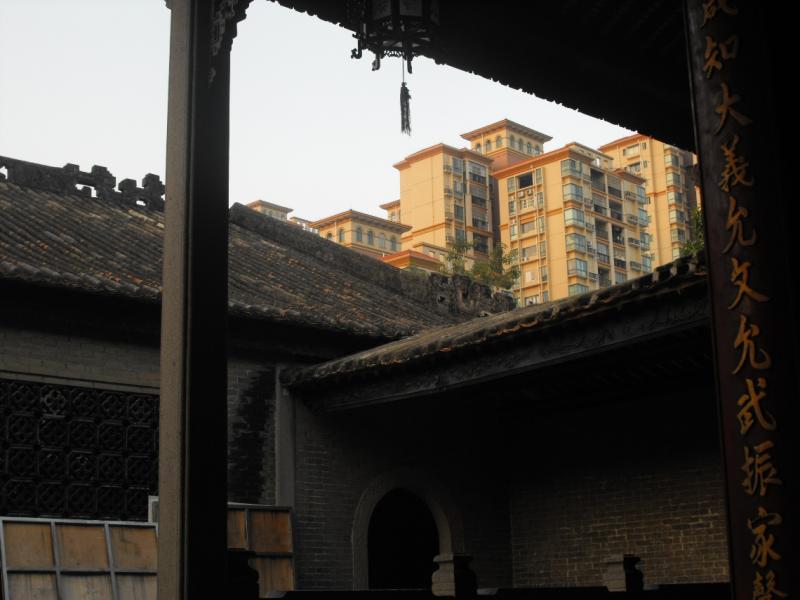
Day one got under way with an afternoon workshop by American beat box artist Butterscotch. Winner of the first World Hip Hop Beat box Women's Championship in 2005, Butterscotch has since performed with Earth Wind & Fire, pianist Chick Corea and singer Patti Austin, as well as recording with bassists Stanley Clarke, Marcus Miller and Victor Wooten on Thunder (Heads Up International, 2008) and with guitarist/singer George Benson on Songs and Stories (Concord, 2009).
A rapt audience was treated to a thoroughly engaging and informative presentation, which started with a brief history of vocal tradition and body percussion from Africa to India. Butterscotch's recreation of snare and bass drums, hi-hat and drum fills, scratching, rap and trumpet-using only her voice and a microphone-was a revelation to those in attendance.
There was a healthy amount of individual and crowd participation in an enjoyable one-hour session. Butterscotch's easy-going manner was as pleasant as her ability to manage an audience was striking. She wrapped up her workshop by imparting some words of wisdom to those present: "Always practice slowly, and practice individual sounds," she advised. No doubt more than one Zhuhai youngster went home thinking, "Hey, I can do this!"
Just four rows of three-meter-long benches in the concert hall suggested that the audiences might be very small indeed, but by the time the Signe Juhl Quartet took to the stage, the benches were lost in the throng, with the crowd packing the theatre from wall to wall. The bare-footed singer Juhl led her Danish quartet through a swinging set of jazz standards dating from the first half of the twentieth century. Turner Layton/Henry Clayton's' "After You're Gone" from 1918 set the ball rolling in gently bluesy fashion. This was followed by the first of two George Gershwin/ Ira Gershwin numbers, "Oh, Lady Be Good," which featured some nice unison lines between Juhl and guitarist Bo Moller-who injected a little of the modern-day in proceedings with a biting solo-and "They All Laughed."
 The quartet, rounded out by the impressive rhythm team of drummer Casper Mikkelsen and bassist Niels Kvist, then gave an intimate rendition of pianist Fats Waller's "Honeysuckle Rose," with Juhl's powerful vocal at song's end receiving a tremendous ovation from the crowd.
The quartet, rounded out by the impressive rhythm team of drummer Casper Mikkelsen and bassist Niels Kvist, then gave an intimate rendition of pianist Fats Waller's "Honeysuckle Rose," with Juhl's powerful vocal at song's end receiving a tremendous ovation from the crowd. An original feature of the Beishan International Jazz Festival was a screen mounted to the right of the stage which alternated between relaying the concerts in real time and showing Tweets that audience members posted. Over the two evenings, around 1,300 Tweets were posted-the majority in Chinese-the first of which, after "Honeysuckle Rose," read: "I'm very touched. This is very exciting."
A little bossa nova and singer Peggy Lee/Dave Barbour's "It's a Good Day" brought a highly enjoyable, swinging set to a conclusion, with Moller saving his best to last, igniting the crowd with a lively solo. In another feature of the BIJF, after each performance the artists entered the hall to rapturous applause through a side-door, and under the glare of a spotlight walked along a red carpet through a guard of honor provided by the green-shirted volunteers. They then signed CDs, posters and t-shirts like crazy for fifteen or twenty minutes before exiting the way they came, once again to generous applause and general hoopla fanned by the emcees. Show-bizzy perhaps, but the razzmatazz was enjoyed by artists and audience alike, and in general, the treatment of musicians, media and guests was outstanding.
Tweet: "Jazz I love you!"
Though YouTube is banned in China, the ingenuity that characterizes the Chinese no doubt means there is a way to navigate around the ban, and should any of the audience choose to check out any of the Signe Juhl Quartet's covers on video, they are going to find their way to jazz giants such as singers Nina Simone, Ella Fitzgerald and Bessie Smith, trumpeters Louis Armstrong and Chet Baker, saxophonist Eric Dolphy, guitarists Eddie Lang and Django Reinhardt, violinist Stephane Grappelli, pianists Art Tatum, Count Basie and Thelonious Monk, clarinetist Benny Goodman and vibraphonist Lionel Hampton, to name just a handful of artists who have performed these songs in a variety of jazz styles.
The Li Gao Yang Quartet, the first of two Chinese bands, was next up. Li, at just 18 years of age, has been playing saxophone since the age of six, and in a very short time has made a name for himself as a musician to watch out for. Li was one of several artists who officially inaugurated the Hong Kong International Jazz Festival 2011, and this was his second appearance at the Beishan International Jazz Festival. Li is unashamedly old school, and whether on tenor or soprano, his vocabulary drew mainly from bebop and hard bop.
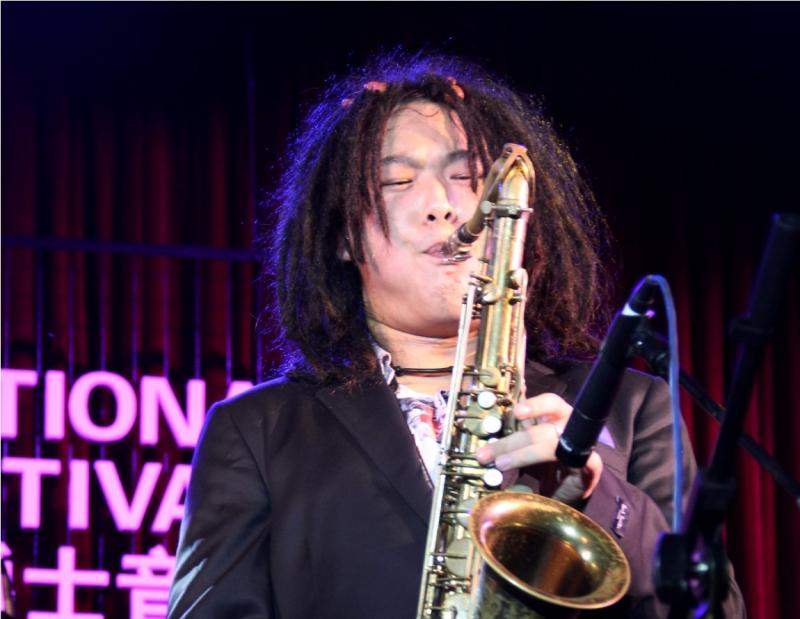
Li's technical command of his tenor was evident from the start of the self-penned "Akane," but there's much more in his bag than mere virtuosity. His barreling solo in tandem with drummer Cameron Reid showed plenty of saxophonist John Coltrane's influence, and like Coltrane, the blues is ever present in Li's voice. Just as impressive, however, was his leadership; quietly commanding the quartet in undemonstrative manner, Li was generous with the space he accorded the other musicians, showing a musical maturity beyond his years.
Tweet: Crazy. High quality. Perfect.
Bassist Rickard Malmsten's "Traveler" slowed things down, with Reid using hands in lieu of sticks and Jim Schneider's electric piano imbuing a gentle melodicism at the song's outset. Extended solos from the bassist and pianist paved the way for the leader's tango-ish tenor solo. On this number and on "Brooklyn Dream," melody lay at the heart of the ensemble interplay. The quartet raised a head of steam on tenor player Sonny Stitt's much covered "Eternal Triangle." If high-octane bebop was new to any of the 18-20-something year-old members of the audience, they certainly got a powerful, authentic introduction to it, with saxophone and drums once again trading phrases in a mise en scene that might have resembled alto player Charlie Parker and drummer Max Roach on 52nd Street in the 1940s.
Li's quartet rounded off an exciting, energetic set with a touch of up-tempo jazz-funk. "222" was straight from the mold of saxophonist Grover Washington, with touches of bluesy electric piano accompanying another telling solo from the leader on tenor. Singer Stevie Wonder's "Isn't She Lovely?" provided a sunny end note to the most classically jazz-inspired set of the two days, and judging by the crowd's reaction throughout, Beishan is up for more of the same.
Tweet: "Wonderful and magical place!"
Cameroonian-born Dutch singer Ntjam Rosie is a rising vocal talent, as much influenced by soul and R&B as she is by jazz. Her set was largely drawn from her second album, elle (Ntjam Music, 2010) and she won over the audience with her stylish songs and graceful stage presence. Backed by a tight quartet, Rosie opened with "Roof over My Heart," a soul tune colored by the singer's West African roots. The slow burning "Space of You" saw Rosie floating effortlessly in the higher registers.
Unfortunately, the band had to contend with the intrusive noise from a small contingent of dedicated drinkers parked at the bar at the back of the hall. In an otherwise well organized festival, planting the bar inside the concert hall was an unfortunate move and it would be far better for musicians and fans alike if the bar were outside in future editions.
Keyboardist Alexander van Popta lent a jazz vibe to songs like the flowing "Morning Glow" and the seductive, gently grooving "Serre sa Main," sung in French. The beautiful ballad, "Again and Again," underlined the warmth in Rosie's voice, but was over a tad too quickly. "We All Fear Inside" was a touching, soul-bearing number. The French-sung, African-flavored "Elle Part 1" raised the tempo a notch, followed by a fairly faithful interpretation of singer Bill Wither's 1977 hit "Lovely Day," though Rosie couldn't quite match Wither's 18-second-long note towards the song's end.
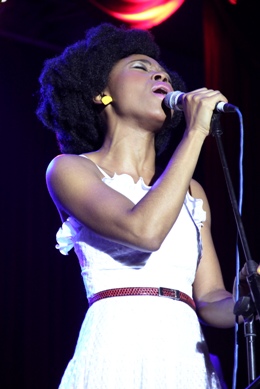 The band was called back for a deserved encore and finished a delightful set with "Atouba" from the singer's debut album of the same name. Ntjam Rosie is a striking vocalist, and the musical space she inhabits has its very own, subtle charms. As she continues to develop and refine her sound it would be a major surprise if she didn't go on to bigger and better things.
The band was called back for a deserved encore and finished a delightful set with "Atouba" from the singer's debut album of the same name. Ntjam Rosie is a striking vocalist, and the musical space she inhabits has its very own, subtle charms. As she continues to develop and refine her sound it would be a major surprise if she didn't go on to bigger and better things. Tweet: "I love jazz."
The final act on day one of the BIJF was Serbian band Eyot. Joint winners of the Umbria Jazz Balkanic Windows Competition in 2009, this highly original quartet unites jazz, classical, folk and rock elements in an intoxicating mix that is at once meditative and invigorating. The set comprised four tunes from the band's debut recording, Horizon (Constantinus, 2010) and three as yet unrecorded tracks.
The kernel of each track stemmed from pianist Dejan Llijic, who uncoiled simple melodies that fell between classical and jazz. On "Stone Upon Stone Upon Stone," his tentative piano intro evolved into an extended improvisation of minimal design. Bassist Marko Stojiljkovic's churning bass ostinato and drummer Milos Vojvodic's drive stoked the band's fire, while guitarist Sladjan Milenovic brought pedal-driven atmospheric waves to the mix. During the set there was little in the way of conventional soloing-the group sound was the thing.
"Surge" was both melodically arresting and quietly brooding-a little like a slow waltz between Esbjorn Svensson and Nirvana at the outset. The band is certainly influenced by the latter group, and in the post-concert interview Llijic said: "I consider [Nirvana singer] Kurt Cobain to be one of the great musicians of the 20th century, on the same level as John Coltrane and Miles Davis." On this number Llijic gave a wonderful, extended exhibition that mapped Serbian folk, classical and jazz contours simultaneously, as the music swelled powerfully around him.
At times-and notably on "All I Want to Say"-there was some of the interlocking, almost mantra-like grooves of Nik Bärtsch's Ronin. Two new numbers, "Coils" and "Drifting," largely followed the established blueprint: simple piano motifs, subtle tremolo guitar effects, and the collective voice rising like a storm brewing. On the former, Milenovic's guitar sounded like cracking ice, an effect heightened by billowing dry ice and an atmospheric light show. Eyot struck a fine balance between pretty melodies that clawed both gut and heart, subtle groove effects and a stirring collective voice. The closing number, "Horizon" embodied all these qualities and was over all too soon.
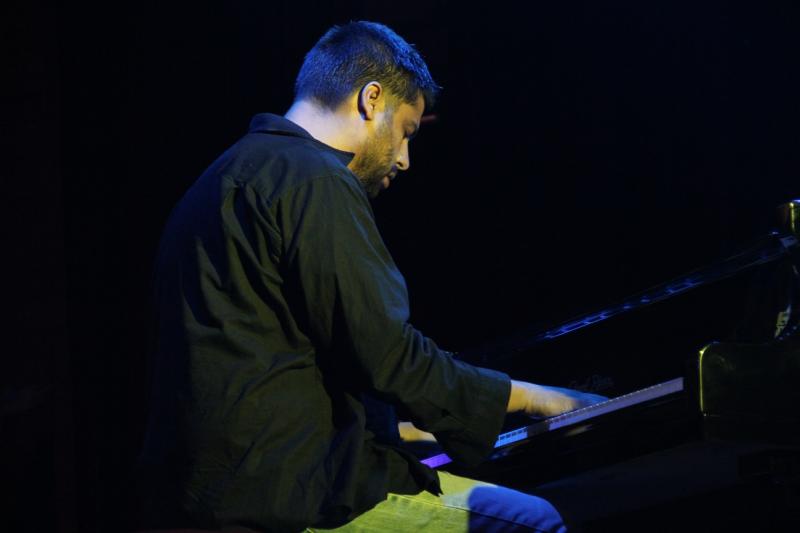
Tweet: "Wow! I never see before. So beautiful."
A portion of the crowd had drifted off after Ntjam Rosie, but the small but very enthusiastic crowd that remained were, in Eyot, treated to one of the most genre-bending, and unique concerts of the two days. The BIJF's stated aim is to become the top jazz festival in southern China (there are currently around eight) and if it continues to be as adventurous with this program in the years to come, then it may well succeed sooner rather than later.
Day 2 of the BIJF began with a children's choir from the TPR English School, giving a recital in English. About two dozen preteens, as cute as buttons all, gave an impressive rendition of a song called "Proud of You," as those family members in attendance surely were of the little singers. The inclusive, socially conscious aspect of the BIJF is to be applauded , though locals from the village of Beishan were put off by the relatively high cost of the tickets. It's no easy task to program a jazz festival in southern China and bring in enough punters to make it financially sustainable. If the BIJF could find a way to open its doors to the more financially-challenged locals it would be a very good PR move.
Another issue which is looming just over the horizon for the BIJF is crowd capacity. By all accounts, the numbers of attendees has grown considerably in the festival's first three editions and the concert hall was mostly packed wall to wall. It was just on the right side of full and festive, though it wouldn't have taken too many more souls to have made standing and moving to and fro uncomfortable. Safety is not the issue, as there are exits galore (five in the concert hall alone) but the organizers may be wise to consider capping ticket sales at an agreed number. After all, there's nothing like a SOLD OUT sign to generate a buzz about a festival.
The first band to take the stage on day 2 of the BIJF was the We Do Big Band from Guangzhou. This 14-piece big band was founded in 1998, and includes professors from the Xinghai Conservatory of Music. Its aim is to promote jazz and educate people about jazz in Guangzhou and beyond. The big band has received instruction from trumpeter Wynton Marsalis, so it was no real surprise that the band's set looked largely to the golden age of big bands for its stylistic direction.
That said, there was no mistaking the verve in the playing and the swing, engendered in the main by pianist Luo Jingtian, bassist Liang Weitang and lively drummer Chai Hualiang, whose time-keeping was impeccable throughout. The first number was a vibrant calling card, a bold, swinging arrangement infused with the blues and, in Jingtian, a touch of boogie woogie. Tenor saxophonist Yu Shen Hai cut a flowing, confident solo, and he impressed throughout the show. On slower numbers, the band displayed sophisticated harmonics and deft counterpoint, though less inspiring was a rather bland arrangement of a tune that evoked a slightly cheesy '70s soundtrack.

Duke Ellington's "in A Mellow Tone" and an upbeat Latin-inspired number earned warm ovations from the appreciative crowd. Singer Zhu Lanlan's stage entrance was met with a great cheer that acknowledged her striking looks and spectacular gown. With just a little of the diva presence about her, she led the band through time-worn classics such as Ellington's "It Don't Mean a Thing," Nina Simone's "I Feel Good" and "Quien Sera?" (better known as "Sway"), the 1953 mambo by Mexican composer/bandleader Pablo Beltran Ruiz.
Tweet: "All the people are so excited."
"Sway" has been recorded in Persian, Arabic, Japanese Vietnamese and most major European languages. It was also recorded in Mandarin in 1968 by Teresa Teng-a Taiwanese singer known to Chinese worldwide-and in Cantonese by Hong Kong singer/actor Aaron Kwok Fu-shing in 2005, so it's well known to several generations of Chinese. Lanlan, obviously enjoying herself, moved graciously around the stage, buoyed by the powerful big band voice, and it made for an appropriately up-beat finale to an impressive performance. The We Do Big Band was greeted with a loud ovation, repeated when the band members entered the hall to sign autographs for a sizeable number of young people.
Guitarist Eduardo Figueiredo has been around longer than his youthful looks suggested, recording over a dozen albums as leader/co-leader since the late 1990's. Twice winner of the Montreux Jazz Festival Guitar Competition, his breathtaking technique and sheer musicality have drawn plaudits at home and abroad, with guitarists George Benson and Pat Metheny lavishing praise on the Brazilian. Benson has described Figuereido as "one of the greatest guitarists I've seen in my whole life," a view shared by Brazilian guitar legend Paulinho Nogueira. Metheny, for his part, referred to Figueiredo's semi-acoustic solo album Segundas Intenções (Self Produced, 2004) as "magic." Few in the audience who witnessed his performance at the head of his trio would disagree with such sentiments.
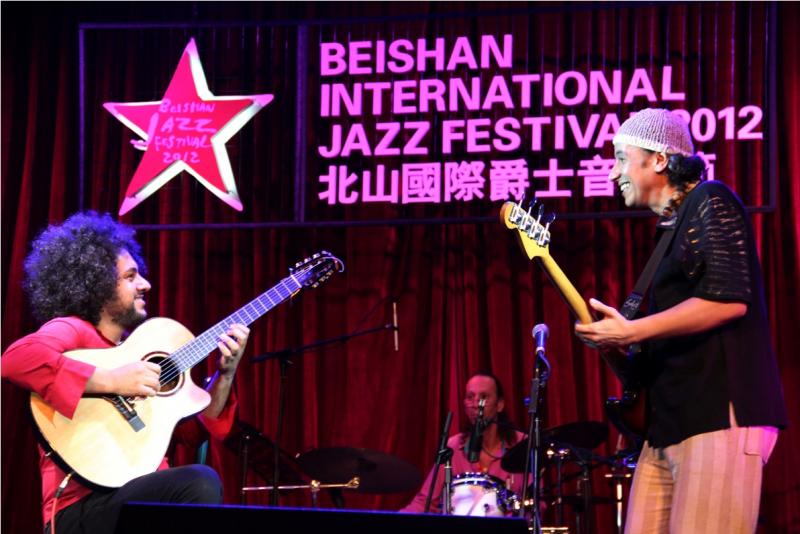
Figueiredo opened the set with a solo piece of astonishing dexterity, which brought gasps and cheers from the audience. He was then joined by veteran percussionist/drummer Alfonso Amir Corre Da Silva on tambourine, whereupon the two developed an engaging, playful dialogue, with Eduardo Machado on bass. A little predictably, perhaps, they regaled the crowd with Antonio Carlos Jobim's One Note Samba" followed quickly by Jobim/ Vinicius De Moraes' "The Girl from Ipanema." No prizes for surprises maybe, but rarely have these much-played bossa nova and samba classics sounded so vibrant or so freshly minted.
Tweet: "Oh, Diego!"
Barely pausing for breath, the trio launched into "Aquarela do Brasil" (popularly known in English simply as "Brazil") by composer/pianist Ary Barroso. Though Figueiredo has long collaborated separately with both Da Silva and Machado, this was only the second gig together as a trio, so the chemistry at play and the sparks that flew were all the more impressive.
Figueiredo is an original talent, though his language is perhaps closest to guitarist/composer Egberto Gismonti for its seamless, exhilarating blend of Brazilian folk, jazz and classical vocabulary. Without a doubt, Figueiredo belongs in the pantheon of Brazilian guitar greats. Playful call-and-response between guitarist and bassist, and then between guitarist and the audience, created a suitably festive atmosphere, which Figueiredo exploited joyously with some lightning-fast runs the length and breadth of his guitar.
The inevitable encore was an original take on Jobim's eternally popular "Wave," which evolved from delicate interplay between Figueiredo and Da Silva on shaker-with the emphasis very much on play-into a riotous, show-stopping solo from the guitarist that will unlikely be forgotten by those present.
As the three musicians were leaving the stage, it seemed that more of the audience was already queuing for autographs than not. It's quite possible that the three Brazilians, obviously led astray early in life by music, haven't written so much since school days.
Tweet: "So wonderful! How Happy I am. I cannot sleep tonight."
How does such a crowd-pleasing concert affect the following artist? Intimidating? Inspiring? Perhaps a bit of both. Beat boxer/multi-instrumentalist Butterscotch-despite her relative youth-has been around the block a few times, so to speak, and her relaxed, yet commanding stage presence meant that the audience was in the palm of her hand from the beginning. Well, most of the audience, for Butterscotch too, had to contend with the disproportionately loud element around the bar area.
Professional to a tee, she asked for a little quiet for her more intimate music, and rose above the brouhaha for the rest of her set. Her brief hip-hop-cum-scratching intro laid down an impressive marker, rocking the crowd with her vocal and rhythmic virtuosity. Her trumpet impersonation was almost as impressive as English singer/guitarist Earl Okin's, but Okin has been around considerably more blocks than Butterscotch. Nevertheless, her guitar playing and singing, particularly on the jazz standard "The Very Thought of You," was seductive, with more than a hint of singer Billie Holiday's influence.
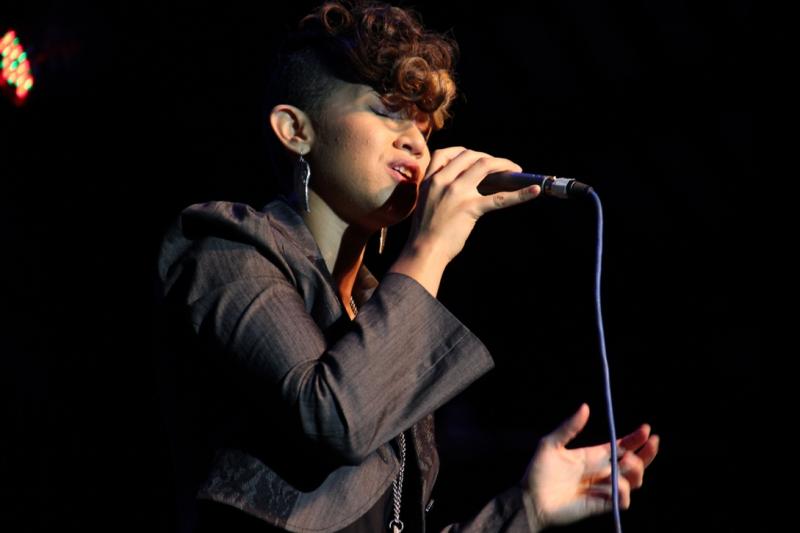
Butterscotch introduced the Gershwin's "Summertime" as having been sung for the first time by her "great, great cousin," Anne Brown, who indeed created the role of Bess in the Gershwin's opera Porgy and Bess in 1935. The singer's trumpet rendition and urbane vocal percussion/rhythms forged a compelling bridge between the past-almost 80 years ago-and the present.
For the Richard Rogers/Lorenzo Hart tune, "My Funny Valentine," Butterscotch sat at the piano-in which she's classically trained-and delivered a hypnotizing interpretation, accompanying herself on bass rhythm and cymbal accents.
Tweet: "So many talented people here. So happy to be here."
A soulful and grooving, jazz-inflected number from her forthcoming album led into "Obsession," previously recorded with bassist Marcus Miller. Butterscotch's concoction of rap, soul, R&B and scratching really lifted the audience. Her encore, a song possibly entitled "Silver Lining," was again evocative of Billie Holiday, though with a more modern groove and a sensational DJ-mixing impersonation that whipped the audience into even greater fervor and closed the set on a considerable high. Volunteers sporting luminous red and green devil's horns provided a cheery guard of honor for Butterscotch, who generously sat for every autograph and photo request.
Tweet: "Can't believe that!"
The honor of closing BIJF 2012 fell to the Luca Ciarla Quartet. All four members hail from south/southeast Italy, and probably for this and no other reason, the quartet's music is sometimes labeled as Mediterranean jazz. This moniker, whilst certainly true, fails to acknowledge the diverse elements in the music. Ciarla is a classically trained violinist; accordionist Vince Abbracciante is a jazz musician; bassist Nicola Di Camillo's background is pop music; percussionist/drummer Francesco Savoretti's myriad colors come from folk music-Italian, Indian, African and Arabic.
The opening track, "Il Vento di Saracene" was a melodic and dramatic synthesis of all these flavors. It took a while for the sound problems to right themselves, but once the festival technicians from Hong Kong had sorted the muddy sound, the quartet's music came through like sunshine piercing a cloudy sky. Abbraciante's first solo of the evening marked him out an unusual accordionist in the sense that his language is not so informed by the accordion great Astor Piazzolla, but by tenor players Sonny Rollins, Dexter Gordon and John Coltrane.
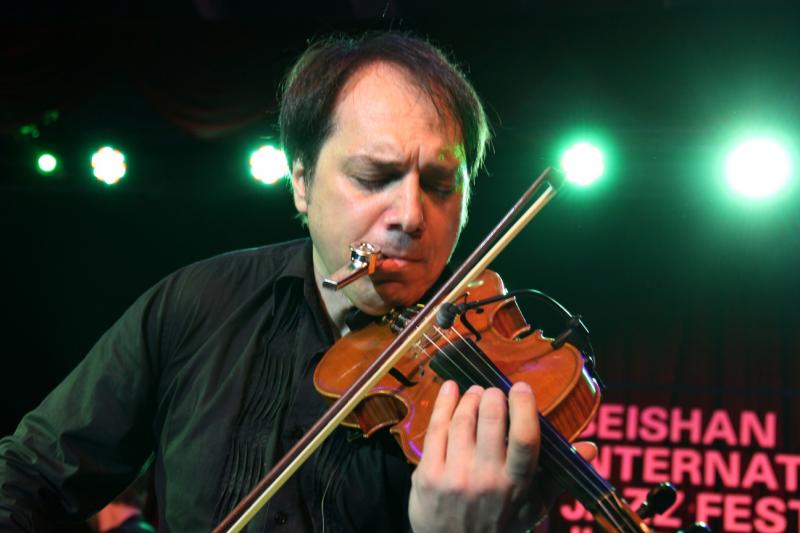
Puerto Rican trombonist and Ellington band member Juan Tizol's "Caravan" was given a new coat of paint, as Ciarla's playing was as informed by Balkan gypsy music as it was by Johann Sebastian Bach. An absorbing exchange took place between bass and percussion, with Savoretti exploring the timbres of cajon, mounted frame drum and tambourine.
Tweet: "Wonderful jazz night! I love it. Something like the old shit!
Introducing "Train," Ciarla explained the band's musical philosophy thus: "Jazz is our home, but music is our God." The minimalist introduction on accordion gave way to a gradually accelerating rhythm. Abbraciante gave a jaw-dropping solo as Tizol's exotic melody was reinvented as a gypsy fling, with Ciarla and accordionist locked in fast unison lines. "Re-Mi Lo-Sol" was a heartfelt dedication to Ciarla's six-month old son, but the tempo picked up once more on a lively version of trumpeter Dizzy Gillespie's "Night in Tunisia."
The distinct timbres of violin and accordion don't necessarily blend harmoniously, so Ciarla danced in and around Abbraciante on the classic Italian partisan song from WWII, "Bella Ciao." Swept up in the music, Abbraciante's improvisation was exhilarating to behold, and he cut striking poses, with body and extended accordion arched like a scorpion about to pounce.
Tweet: "That was fucking amazing!"
It wasn't a scorpion but a tarantella-the frenzied dance once believed to cure victims of tarantula bites-that got the audience jumping. The three-part suite, entitled "Bachtarantellato" summed up everything that the Luca Ciarla quartet offers up to its God of music-Bach, jazz and gypsy folk melodies, in an emotive, swirling concoction that might just have awakened any dormant spirits residing in the nooks and crannies of the old theater and temple buildings. Ciarla added the underemployed kazoo to his armory to nice effect, but it was the heady quartet sound that charged the air, and that was surely carried home in the heads and hearts of the enthusiastic, appreciative audience. The encore saw Butterscotch join the band in a light-hearted, though animated romp through pianist Herbie Hancock's 1964 standard "Cantaloupe Island."

The BIJF is still a baby, but something of a precocious one. This young Chinese audience was clearly open to all the music on offer, and it enjoyed a wide cross section of jazz, stretching from its early incarnations as dance and Broadway-inspired popular music, through the revolution that was bebop to more modern urban rhythms beloved of a younger generation. In addition, the Beishan Theater reverberated to the cross-pollination of jazz with world folk music, and left-field jazz-rock, which, whilst not at all resembling the first wave of jazz-rock in the late 1960s and early 1970s, nevertheless shared a similar spirit of adventure.
If, after two rather eclectic days' music, the Chinese festival goers, aged 18-25 in the main, were left scratching their heads as to what exactly jazz is, they needn't worry-so is almost everybody else. All jazz's styles since the beginning of the 20th century can be heard today in concert, all over the world. There is much overlapping of styles and there should be room for all.
Jazz is perhaps most simply defined as an approach to making music, with whatever tools are at hand. The Beishan jazz audience seems to appreciate that. Its open-mindedness and enthusiasm for the music is probably the biggest factor that will draw all manner of musicians to play here in the future, thus ensuring the continued growth of this wonderful little festival.
Tweet: "Thanks Beishan for giving me two wonderful days!"
Photo Credits
Ian Patterson: page 1, bottom; pages 2,5 top; page 7.
All other photos: Xiaojing Lee
Comments
Tags
Live Reviews
Ian Patterson
China
Steinar Raknes
Rusconi
simin tander
In the Country
Chick Corea
Stanley Clarke
Marcus Miller
Victor Wooten
george benson
George Gershwin
Ira Gershwin
Fats Waller
Peggy Lee
Dave Barbour
Nina Simone
Ella Fitzgerald
Bessie Smith
Louis Armstrong
Chet Baker
Eric Dolphy
Eddie Lang
Django Reinhardt
Stephane Grappelli
Art Tatum
Count Basie
Thelonious Monk
Benny Goodman
Lionel Hampton
John Coltrane
Sonny Stitt
Charlie Parker
Max Roach
Stevie Wonder
Esbjorn Svensson Trio
Miles Davis
Nik Bartsch
wynton marsalis
duke ellington
pat metheny
Antonio Carlos Jobim
Vinicius De Moraes
Egberto Gismonti
Billie Holiday
Sonny Rollins
Dexter Gordon
Juan Tizol
Dizzy Gillespie
Herbie Hancock
For the Love of Jazz
 All About Jazz has been a pillar of jazz since 1995, championing it as an art form and, more importantly, supporting the musicians who create it. Our enduring commitment has made "AAJ" one of the most culturally important websites of its kind, read by hundreds of thousands of fans, musicians and industry figures every month.
All About Jazz has been a pillar of jazz since 1995, championing it as an art form and, more importantly, supporting the musicians who create it. Our enduring commitment has made "AAJ" one of the most culturally important websites of its kind, read by hundreds of thousands of fans, musicians and industry figures every month.






















